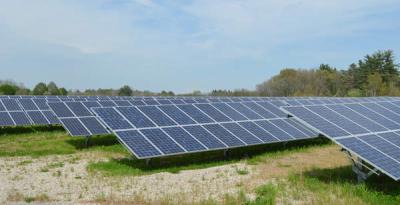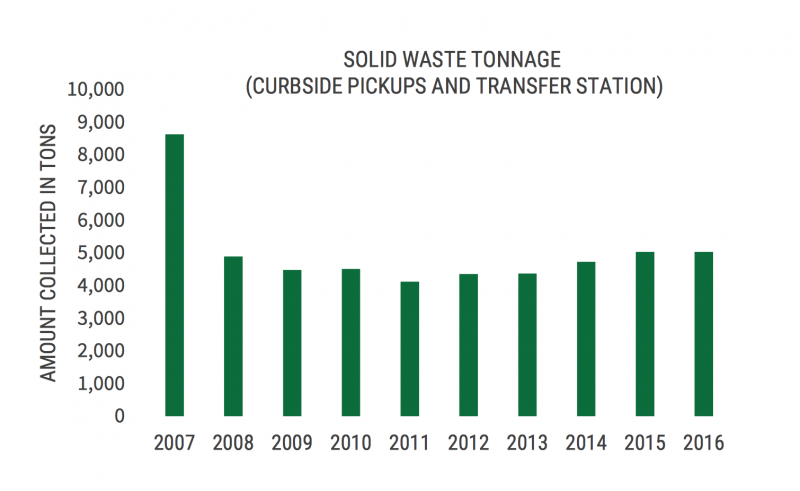Town lowers energy use, increases recycling
In 2016, Dartmouth residents recycled nearly 1,455 tons of paper, officials green-lighted more than 300 solar energy projects, and the town reduced its overall energy use by eight percent.
Officials are celebrating successes in the town’s sustainability initiative, the results of which are detailed in the recently released 2016 Sustainability Report. The report contains statistics from the 2016 calendar year for some categories, and the 2016 fiscal year (July 1, 2015 to June 30, 2016) for others.
According to the report, residents also recycled 1,258 tons of glass, plastics, and cans. Compared to 2015, the curbside collection of recycled paper has increased by 4.1 percent, and glass, plastic, and can collection has increased by about 6.5 percent compared to 2015 data.
Officials attribute this to the implementation of the Save Money and Reduce Trash (SMART) program in 2007. How it works is residents are provided two black, 65-gallon, wheeled recycling containers at no cost to them. The year before the SMART program began, residents sent 10,946 tons of garbage to Crapo Landfill, located on the North Dartmouth-Freetown line. In 2015, they sent about 4,820 tons of garbage — a 56-percent reduction. In 2016, residents sent 5,263 tons of garbage, a slight increase over last year’s collection, but nearly a 52-percent decrease since 2007.
Town officials hope to continue increasing recycling efficiency. This month, they kicked off an eight-week curbside engagement program on four of Dartmouth's 10 collection routes, alongside state officials and The Recycling Partnership (a nonprofit focused on improving the recycling system).
How it works is that waste collectors peek inside recycling bins for Dartmouth's biggest recycling offense — plastic bags, plastic wrap (usually seen around multipacks of water, paper towels, etc.), and bagged recyclables. After finding a recycling mishap, workers leave a 4x11-inch "Oops" tag on the recycling bin, with the contents still inside. The goal is to reduce additional cost, worker safety issues, and trash by keeping items like greasy pizza boxes, chains and hoses, and plastic wrap from gumming up the system at the recycling center.
The Department of Public Works also runs a composting program, through which it collects brush from residents and private contractors and uses it to create a compost mixture with dewatered biosolids. The finished compost is sold. Additionally, the design for a $2.6 million ultraviolet disinfection system was 60-percent completed as of December 2016. The new system will allow the town to process sewage more efficiently, while reducing energy usage and the use of toxic chemicals, according to the report.
Supporting solar power.
Between fiscal years 2015 and 2016, Dartmouth has increased its solar capacity by 3.1 megawatts from 308 new solar projects.
“Capacity is like the speed a car can travel (for example, a megawatt), while production (like a megawatt hour) is the distance the car has traveled,” said town Energy Manager Shawn Luz. “We’re trying to make it easier for people who want to go solar to go solar. Right now, we’re leading the Commonwealth in solar capacity.”
As of December 2016, there were 884 total solar energy projects in Dartmouth. That includes eight major solar energy farms that provide energy to the town, as well as to neighboring municipalities. In 2015, Dartmouth produced about 58,925 megawatt hours of electricity, enough to power roughly 7,984 homes in Massachusetts annually, according to the report.
Two of those solar farms — Borrego Landfill Solar Farm and the Energy Park Solar Field — will save the town more than an estimated $13 million over a 20-year power purchase agreement, according to the report.
In 2016, the town began identifying actions it could take to simplify the permitting process for solar installations, as well as revising its zoning bylaws to improve clarity regarding small-scale solar installations. Due to this work, Dartmouth received a bronze designation through the federal Department of Energy’s SolSmart program, an official recognition of the town’s efforts to make it faster, easier, and cheaper to go solar.
Becoming a "green community."
In 2016, Dartmouth adopted the Stretch Code — a performance-based building code that measures the energy efficiency of new residential and specific commercial construction — and became one of Massachusetts designated “green communities.” The new label — which came with a $223,750 grant — enables the town to apply for state monies that promote sustainability and energy-efficient changes.
Such monies are aimed at retrofitting boilers and lighting. Several of those projects, including new boilers for the high school and LED lighting in Southworth Library, have been completed.
The town’s total energy use has dropped eight percent in fiscal year 2016, compared to FY2015, said Luz. “It’s possible that a lot of that is due to a difference in the weather, but our focus on energy efficiency is really important,” he added. “You can see here, [the energy we saved] is mostly from building use. We used a lot less electricity and natural gas.”
Procuring electric vehicles.
In 2015, the town procured six electric vehicles, which it continues to use to supplement its existing fleet of trucks (114), cars (39), vans (29), SUVs (28), buses (6), and motorcycles (2). Charging stations at Town Hall, the Water and Sewer Division Office, and the DPW Main Office building are available for public use.
In the past year, the town has also reduced its diesel fuel usage by about 3,592 gallons. Gasoline usage increased by about 2,893 gallons over the past year, said Luz.
Looking forward, the town aims to reduce its energy consumption by 20 percent over the next five years, a state requirement for green communities. Officials are eyeing lighting updates at the Council on Aging, and designs for the new North Dartmouth library and new police station will also incorporate sustainability features, said Town Administrator David Cressman.
Find the full 2016 Sustainability Report at www.town.dartmouth.ma.us.



















